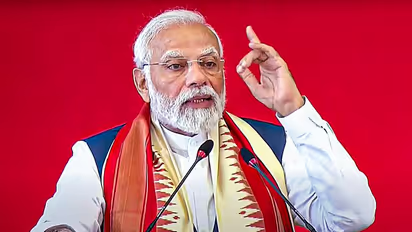India's GDP grew 7.2 per cent in 2022-23; Q4 results beat forecasts

Synopsis
The 7.2 per cent GDP growth is lower than the 9.1% the last fiscal. The January-March quarter growth was at 6.1 per cent, which is higher than the 4.5 per cent in the third quarter. The quarterly GDP growth rate has risen after falling for two consecutive quarters.
In a resounding endorsement of the policies of the Narendra Modi government, India’s GDP expanded by 7.2% last year. That means that India had one of the fastest growth rates among major world economies.
The 7.2 per cent GDP growth is lower than the 9.1% the last fiscal. The January-March quarter growth was at 6.1 per cent, which is higher than the 4.5 per cent in the third quarter. The quarterly GDP growth rate has risen after falling for two consecutive quarters.
"Real GDP in the year 2022-23 is estimated to attain a level of Rs 160 lakh crore, as against First Revised Estimates of GDP for the year 2021-22 of Rs 150 lakh crore. Growth in real GDP during 2022-23 is estimated at 7.2% as compared to 9% in 2021-22," the statistics ministry said in a note.
The Full Statement of the National Statistical Office Is Available Below
According to information received, in the fourth quarter, the Agricultural sector grew by 10.3 per cent, the mining sector recorded a growth of 16.3 per cent and the construction sector grew by 10.4 per cent.
The government data substantiates the bullish position on India held by Morgan Stanley earlier today.
The data released by the National Statistical Office (NSO) further said that the economy expanded 7.2 per cent in 2022-23 against a 9.1 per cent growth in 2021-22.
The NSO in its second advance estimate of national accounts had pegged the country's growth at 7 per cent for 2022-23. China has registered an economic growth of 4.5 per cent in the first three months of 2023.
What Morgan Stanley said about India
According to Morgan Stanley, India, under Prime Minister Narendra Modi, had gaining a position in the world order and is becoming a key driver for Asia and global growth.
In a report, Morgan Stanley said significant scepticism about India, particularly with overseas investors, ignores the significant changes that have taken place in India, especially since 2014.
Rejecting criticism that India has not delivered its potential (despite it being the second-fastest-growing economy and among the top-performing stock markets over the past 25 years) and that equity valuations are too rich, saying such a view ignores the systematic reforms in the last nine years.
"This India is different from what it was in 2013. In a short span of 10 years, India has gained positions in the world order with significant positive consequences for the macro and market outlook," it said. "India has transformed in less than a decade."
Listing the 10 big changes that have happened since Prime Minister Narendra Modi took office in 2014, the brokerage said bringing corporate tax at par with peers and infrastructure investment picking pace are one of the biggest supply-side policy reforms.
Also, the rising collection of GST -- the uniform tax that replaced more than a dozen different central and state taxes -- and the rising share of digital transactions as a percentage of GDP indicate the formalisation of the economy.
Transfer of subsidies to accounts of beneficiaries, insolvency and bankruptcy code, flexible inflation targeting, focus on FDI, government support for corporate profits, a new law for the real estate sector and MNC sentiment at multi-year high were other significant changes, it said.
Stay updated with all the latest Business News, including market trends, Share Market News, stock updates, taxation, IPOs, banking, finance, real estate, savings, and investments. Track daily Gold Price changes, updates on DA Hike, and the latest developments on the 8th Pay Commission. Get in-depth analysis, expert opinions, and real-time updates to make informed financial decisions. Download the Asianet News Official App from the Android Play Store and iPhone App Store to stay ahead in business.